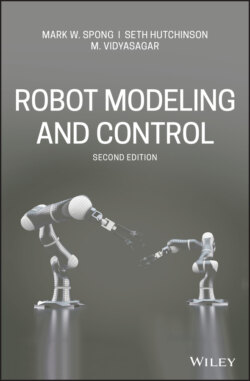Читать книгу Robot Modeling and Control - Mark W. Spong - Страница 56
2.2.2 Rotations in Three Dimensions
ОглавлениеThe projection technique described above scales nicely to the three-dimensional case. In three dimensions, each axis of the frame o1x1y1z1 is projected onto coordinate frame o0x0y0z0. The resulting rotation matrix R ∈ SO(3) is given by
As was the case for rotation matrices in two dimensions, matrices in this form are orthogonal, with determinant equal to 1 and therefore elements of SO(3).
Example 2.1.
Suppose the frame o1x1y1z1 is rotated through an angle θ about the z0-axis, and we wish to find the resulting transformation matrix . By convention, the right hand rule (see Appendix B) defines the positive sense for the angle θ to be such that rotation by θ about the z-axis would advance a right-hand threaded screw along the positive z-axis.
From Figure 2.3 we see that
and
while all other dot products are zero. Thus, the rotation matrix has a particularly simple form in this case, namely
(2.3)
Figure 2.3 Rotation about z0 by an angle θ.
The rotation matrix given in Equation (2.3) is called a basic rotation matrix (about the z-axis). In this case we find it useful to use the more descriptive notation instead of to denote the matrix. It is easy to verify that the basic rotation matrix has the properties
(2.4)
(2.5)
which together imply
(2.6)
Similarly, the basic rotation matrices representing rotations about the x and y-axes are given as (Problem 2–8)
(2.7)
(2.8)
which also satisfy properties analogous to Equations (2.4)–(2.6).
Example 2.2.
Consider the frames o0x0y0z0 and o1x1y1z1 shown in Figure 2.4.
Projecting the unit vectors x1, y1, z1 onto x0, y0, z0 gives the coordinates of x1, y1, z1 in the o0x0y0z0 frame as
The rotation matrix specifying the orientation of o1x1y1z1 relative to o0x0y0z0 has these as its column vectors, that is,
Figure 2.4 Defining the relative orientation of two frames.
